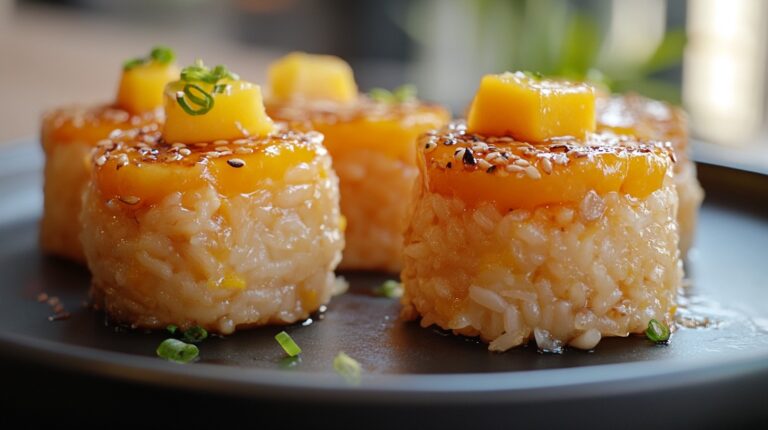Asian desserts bring together captivating flavors, textures, and vibrant presentations.
These sweet creations highlight traditional ingredients like tropical fruits, glutinous rice, and coconut milk, transforming them into irresistible treats.
Each dessert offers something delightful to enjoy, making them perfect for celebrations or simply savoring at home.
Now we want to provide you with some iconic Asian desserts you should check out.
1. Mango Sticky Rice
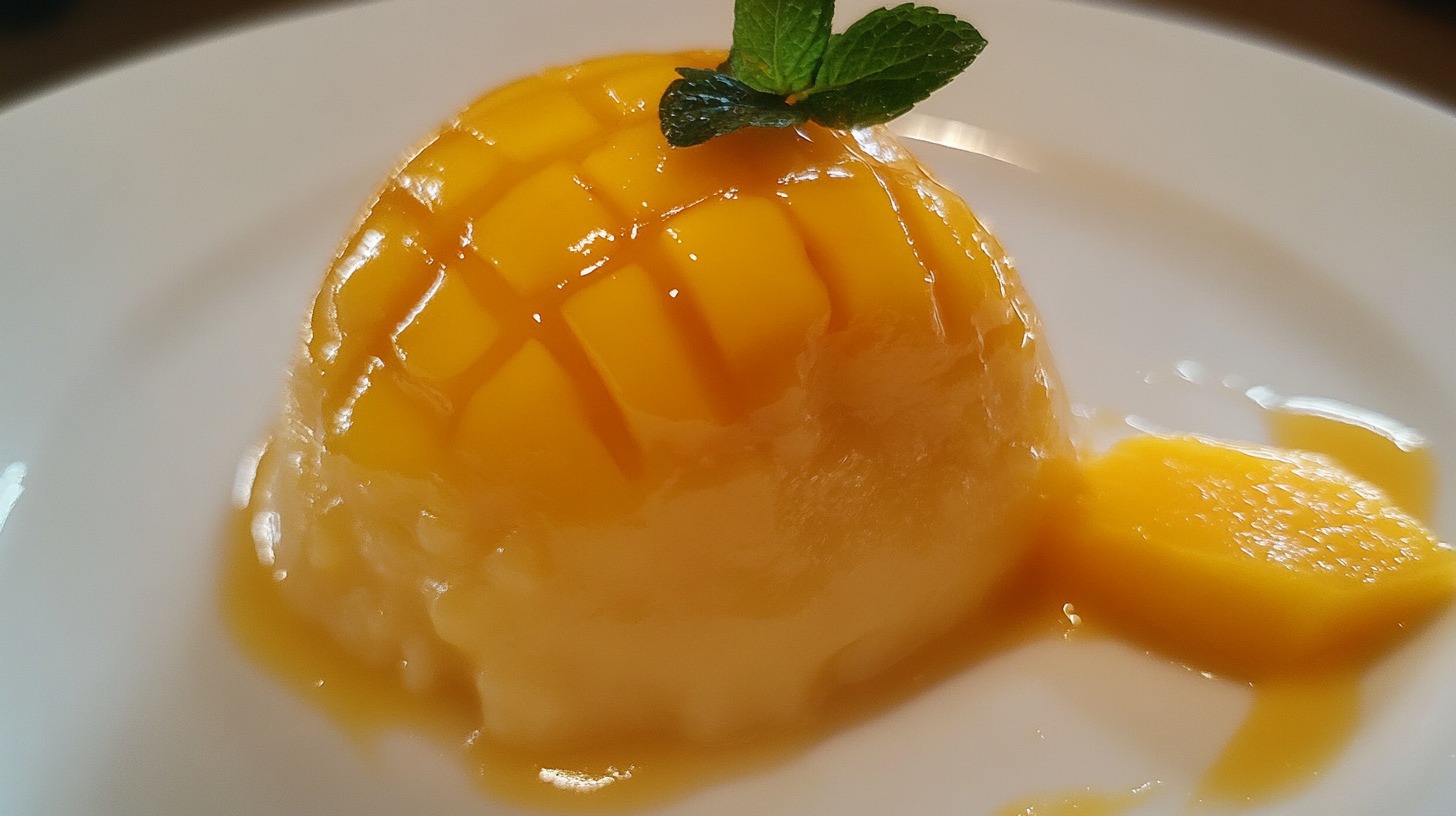
- Sticky rice (1 cup)
- Ripe mangoes (2 large)
- Coconut milk (1 can or about 400 ml)
- Sugar (4-5 tablespoons, adjust to taste)
- Salt (1/4 teaspoon)
Mango sticky rice is one of those Asian desserts that will certainly attract your attention. Begin by rinsing the sticky rice thoroughly under cold water to remove excess starch. Soak the rice in water for at least 4-6 hours or overnight to achieve the perfect texture.
Once soaked, drain the rice and steam it in a bamboo or metal steamer for about 20-25 minutes, or until the grains are tender and translucent.
While the rice is steaming, prepare the coconut milk syrup. In a small saucepan, combine the coconut milk, sugar, and salt. Heat over medium-low heat, stirring constantly until the sugar dissolves.
Be careful not to boil the mixture as it can alter the texture. Once ready, set aside a small portion of the coconut syrup for drizzling later.
Transfer the hot, steamed sticky rice into a large mixing bowl. Gradually pour the warm coconut milk syrup over the rice, stirring gently to ensure all the grains are evenly coated. Cover the bowl and let the rice sit for 10-15 minutes, allowing it to absorb the creamy, sweet richness.
2. Japanese Soufflé Cheesecake
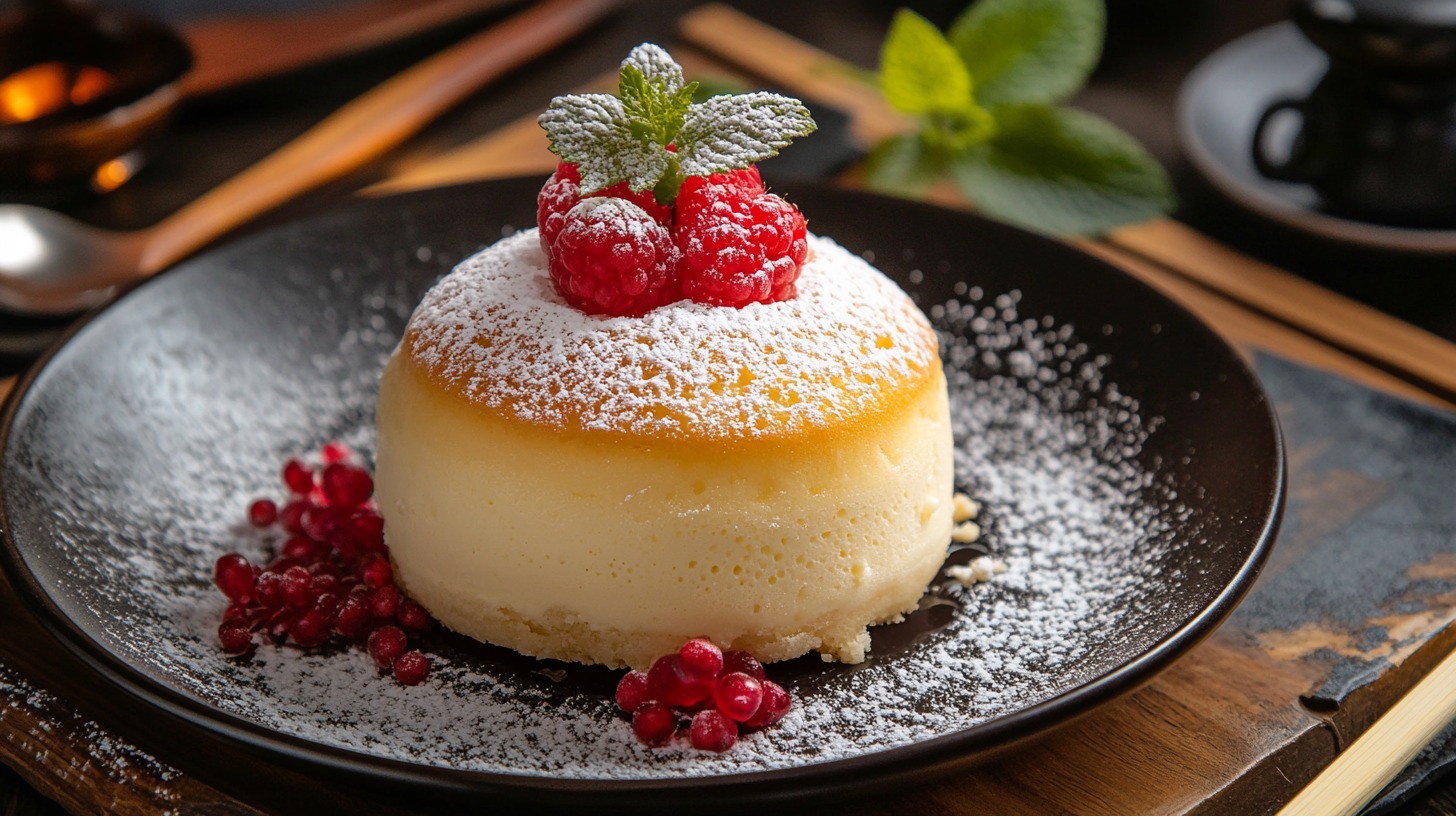
- Cream cheese (200g, softened)
- Eggs (4 large)
- Sugar (100g or about 1/2 cup)
- Milk (100ml or about 1/2 cup)
- All-purpose flour (50g or about 1/3 cup)
- Cornstarch (10g or 1 tablespoon, optional for added structure)
- Lemon juice (1 tablespoon, optional for flavor)
Start by preheating your oven to 320°F (160°C) and preparing a 7-inch round cake pan. Line the bottom with parchment paper and wrap the outside with aluminum foil to prevent water from seeping in during the water bath.
In a mixing bowl, beat the softened cream cheese until smooth and creamy. Gradually add the milk, mixing well to create a lump-free consistency.
Sift in the flour and cornstarch, then add the egg yolks one at a time, stirring after each addition. For extra flavor, stir in a tablespoon of lemon juice to give the batter a subtle tanginess.
In a separate bowl, whip the egg whites with an electric mixer until frothy. Gradually add the sugar while continuing to beat until stiff peaks form.
Carefully fold the meringue into the cream cheese batter in three batches. Use a gentle folding motion to avoid deflating the air in the meringue. Continue until the mixture is smooth and well combined.
Pour the batter into the prepared cake pan and smooth the surface. Place the pan in a larger baking dish, then fill the dish with hot water until it reaches halfway up the sides of the cake pan. This water bath ensures even, gentle cooking and prevents cracks on the surface.
Bake the cheesecake for 50-60 minutes, or until the top is lightly golden and the cake has a slight jiggle when shaken.
3. Bánh Flan (Vietnamese Crème Caramel)
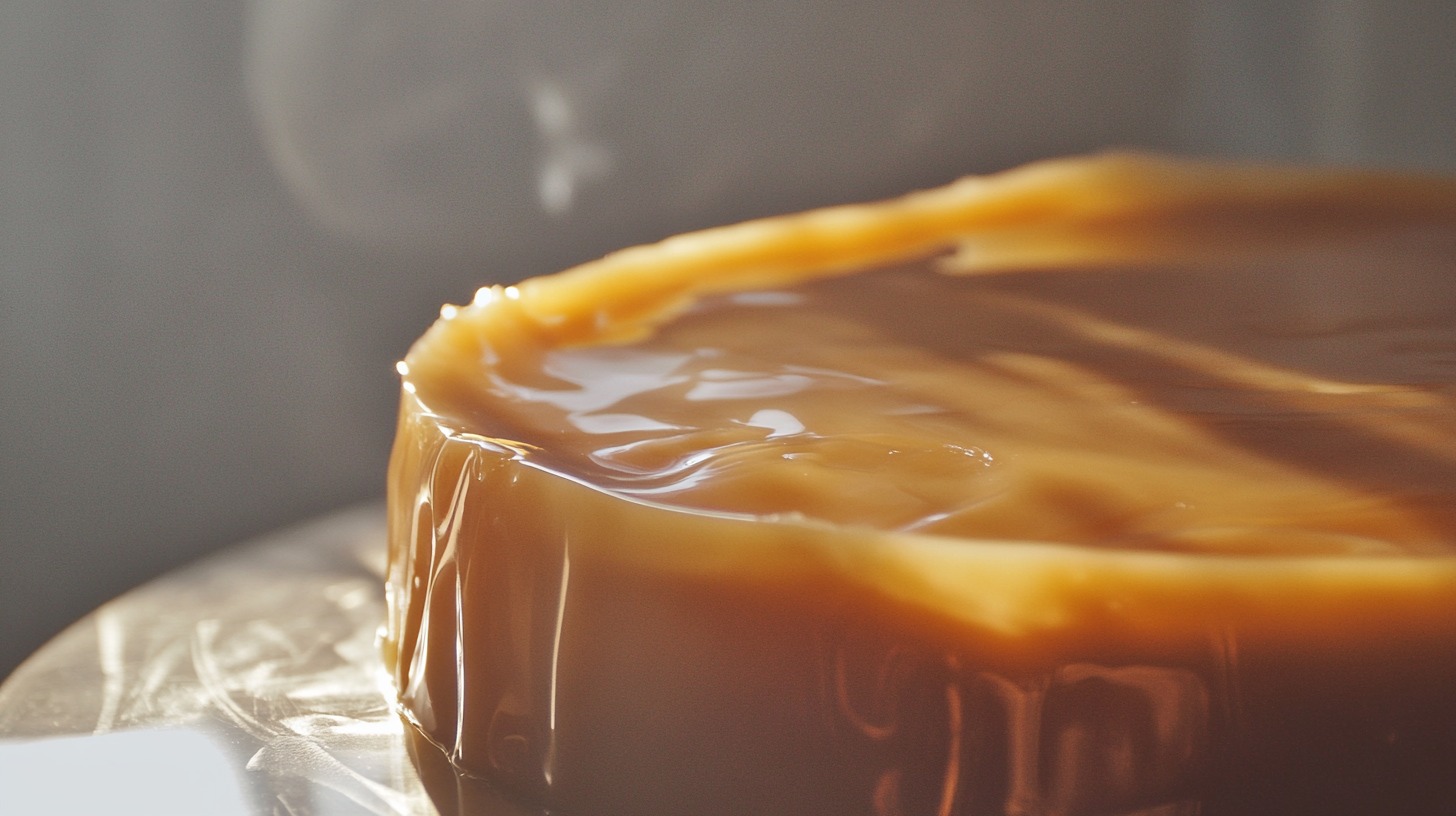
- Eggs (4 large)
- Sweetened condensed milk (1 cup)
- Whole milk (1 1/2 cups)
- Sugar (1/2 cup for caramel)
- Vanilla extract (1 teaspoon)
Start by preparing the caramel base. In a saucepan over medium heat, melt the sugar evenly. Stir occasionally until it turns into a golden, amber-colored liquid. Be careful not to burn it, as caramel can quickly go from perfect to bitter.
Once melted, immediately pour the hot caramel into the base of individual ramekins or heatproof bowls, tilting each one slightly to spread the caramel evenly. Set them aside to allow the caramel to harden.
In a mixing bowl, whisk the eggs until fully combined but not frothy. Add the condensed milk, whole milk, and vanilla extract, stirring gently to create a smooth custard mixture. Avoid over-mixing to prevent incorporating air, which can cause bubbles in the final flan.
Strain the custard mixture through a fine sieve to remove any lumps, ensuring a silky texture. Carefully pour the mixture over the hardened caramel in the ramekins, filling them almost to the top.
Prepare a steaming setup by placing the ramekins in a large pot with a lid. Add hot water to the pot, enough to reach halfway up the sides of the ramekins, creating a water bath.
Cover the pot and steam the flan over medium-low heat for about 25-30 minutes. Test for doneness by inserting a toothpick into the center; it should come out clean.
Once steamed, remove the ramekins from the pot and allow them to cool to room temperature. Cover with plastic wrap and chill in the refrigerator for at least 2 hours or until fully set.
4. Pandan Waffles
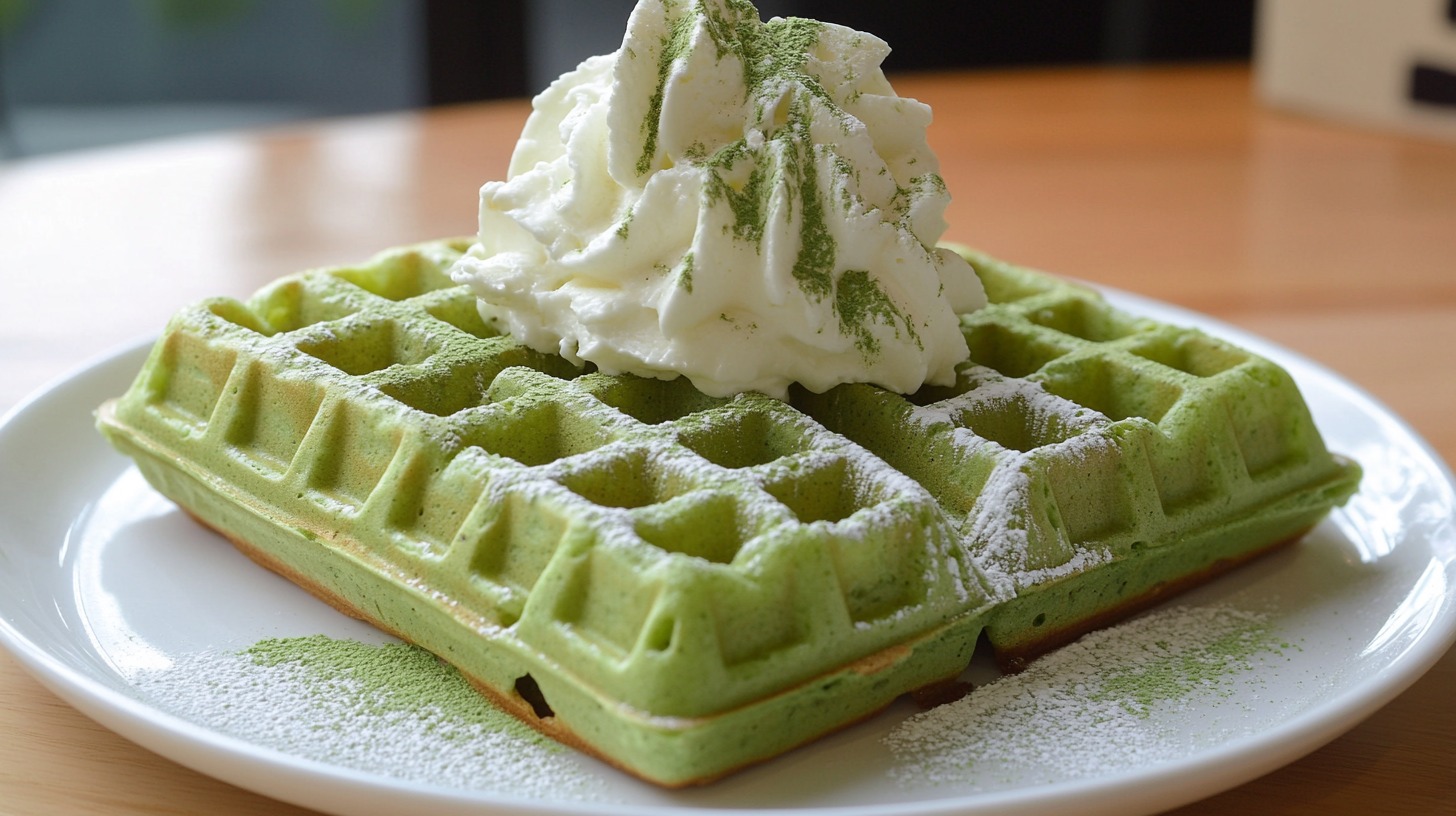
- Pandan juice (1/2 cup, freshly extracted or from a concentrate)
- Coconut milk (1 can or about 400 ml)
- Rice flour (1 cup)
- Tapioca flour (1/2 cup)
- Sugar (1/2 cup, adjust to taste)
- Baking powder (1 teaspoon, optional for extra fluffiness)
- A pinch of salt
To start, prepare pandan juice if using fresh pandan leaves. Blend several pandan leaves with water and strain the mixture to extract the vibrant green juice. If using pandan concentrate, dilute it slightly according to the instructions for a balanced flavor.
In a large mixing bowl, combine the rice flour, tapioca flour, sugar, and a pinch of salt. Stir these dry ingredients until evenly distributed. In a separate bowl, whisk together the coconut milk and pandan juice.
Gradually pour the wet mixture into the dry ingredients while stirring continuously to create a smooth, lump-free batter. If you prefer fluffier waffles, you can add a teaspoon of baking powder to the mix.
Preheat your waffle iron and lightly grease it with oil or butter to prevent sticking. Once hot, pour an appropriate amount of batter into the iron, spreading it evenly to ensure a full waffle.
Close the iron and cook for 3-5 minutes, or until the waffle is crisp and golden on the outside, with a fragrant pandan aroma filling the air.
Carefully remove the waffle and repeat the process with the remaining batter. Serve the pandan waffles warm, either plain or with toppings such as sweetened condensed milk, fresh fruit, or a sprinkle of powdered sugar.
5. Mochi Donuts
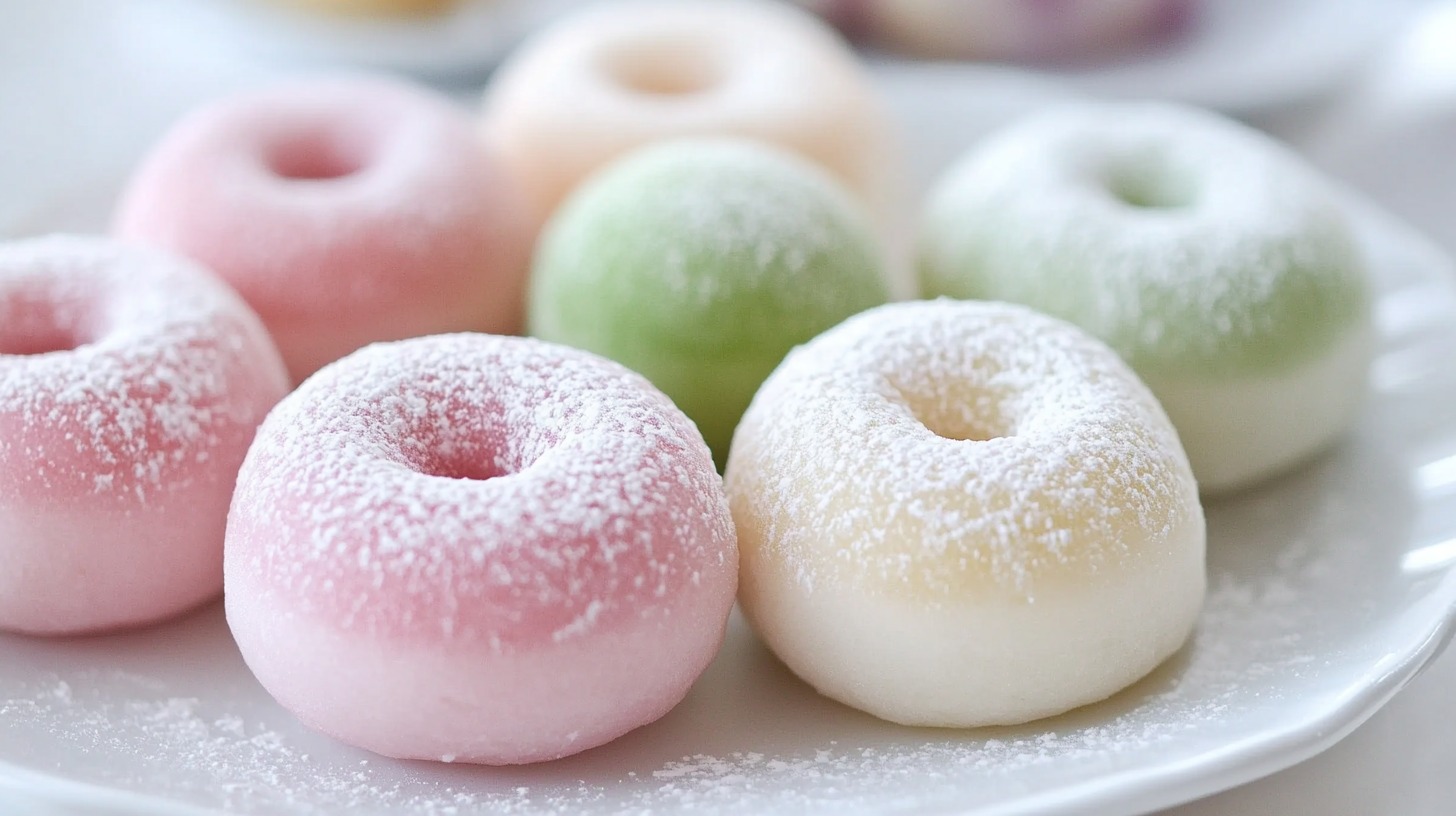
- Glutinous rice flour (2 cups)
- Sugar (1/4 cup)
- Milk (3/4 cup, adjust as needed)
- Eggs (2 large)
- Baking powder (1 teaspoon)
In a large mixing bowl, combine the glutinous rice flour, sugar, and baking powder, ensuring the dry ingredients are evenly mixed. In a separate bowl, whisk together the milk and eggs until well blended.
Gradually pour the wet mixture into the dry ingredients, stirring continuously to form a soft and pliable dough. If the dough feels too dry, add a bit more milk, one tablespoon at a time, until it reaches the desired consistency.
Once the dough is ready, divide it into small, equal portions. Roll each portion into a smooth ball, then shape the balls into rings by pressing a finger through the center and gently widening the hole.
Heat a deep pan with oil over medium heat until it reaches about 350°F (175°C). Carefully drop the shaped dough rings into the hot oil, frying a few at a time to avoid overcrowding the pan. Fry each donut for 2-3 minutes per side, or until they puff up and turn a beautiful golden brown.
Remove the donuts with a slotted spoon and place them on a wire rack lined with paper towels to drain excess oil.
Allow the mochi donuts to cool slightly before adding your choice of finishing touches. Dip them in a glaze made with powdered sugar and milk, or coat them with chocolate, matcha, or strawberry icing.
6. Sesame Balls (Jian Dui)
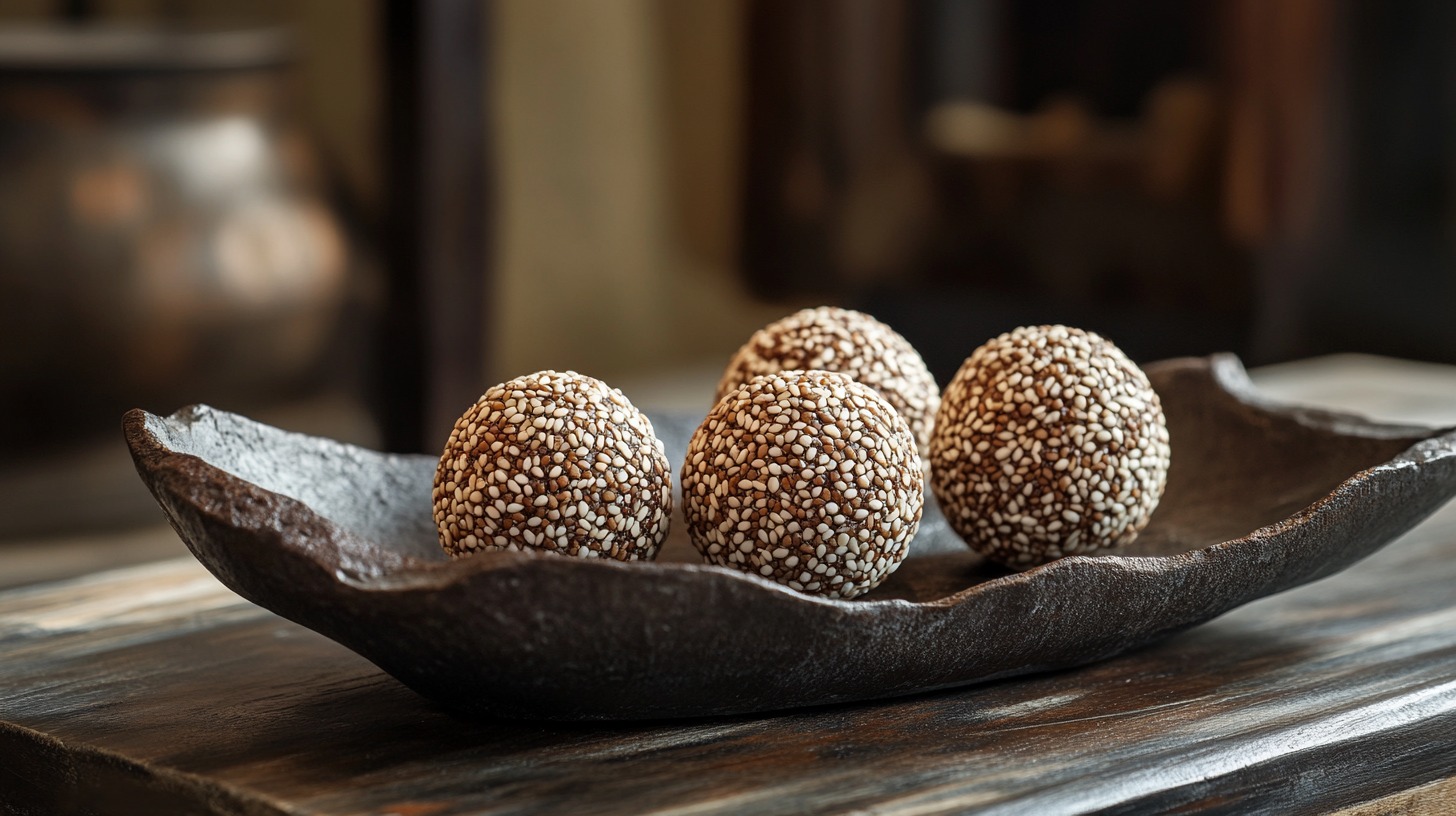
- Glutinous rice flour (2 cups)
- Red bean paste (1 cup, prepared or store-bought)
- Sesame seeds (1 cup, white or a mix of black and white)
- Water (about 3/4 cup)
- Sugar (2 tablespoons, optional)
- Oil (for deep-frying)
Begin by preparing the dough. In a mixing bowl, combine glutinous rice flour with sugar (if desired) for a slightly sweet dough. Gradually add water, mixing continuously until a smooth, pliable dough forms. The dough should be soft but not sticky.
Cover the dough with a damp cloth and let it rest for 10-15 minutes.
While the dough rests, prepare the sesame seeds by spreading them out on a plate. Divide the red bean paste into small portions, roughly the size of a teaspoon, and roll them into balls. These will serve as the filling for your sesame balls.
After resting, divide the dough into small portions, each about the size of a golf ball. Flatten each piece of dough into a round disc and place a red bean paste ball in the center. Carefully wrap the dough around the filling, pinching the edges to seal completely.
Roll the filled ball between your palms to ensure it is smooth and even. Next, coat each ball in sesame seeds. Roll the dough ball on the plate of sesame seeds, pressing gently to ensure the seeds adhere evenly to the surface.
Heat oil in a deep pan or fryer to about 350°F (175°C). Carefully lower the sesame balls into the hot oil in small batches. Fry them for about 6-8 minutes, turning occasionally, until they are golden brown and crispy. The sesame balls will puff slightly as they cook.
7. Ube Champorado
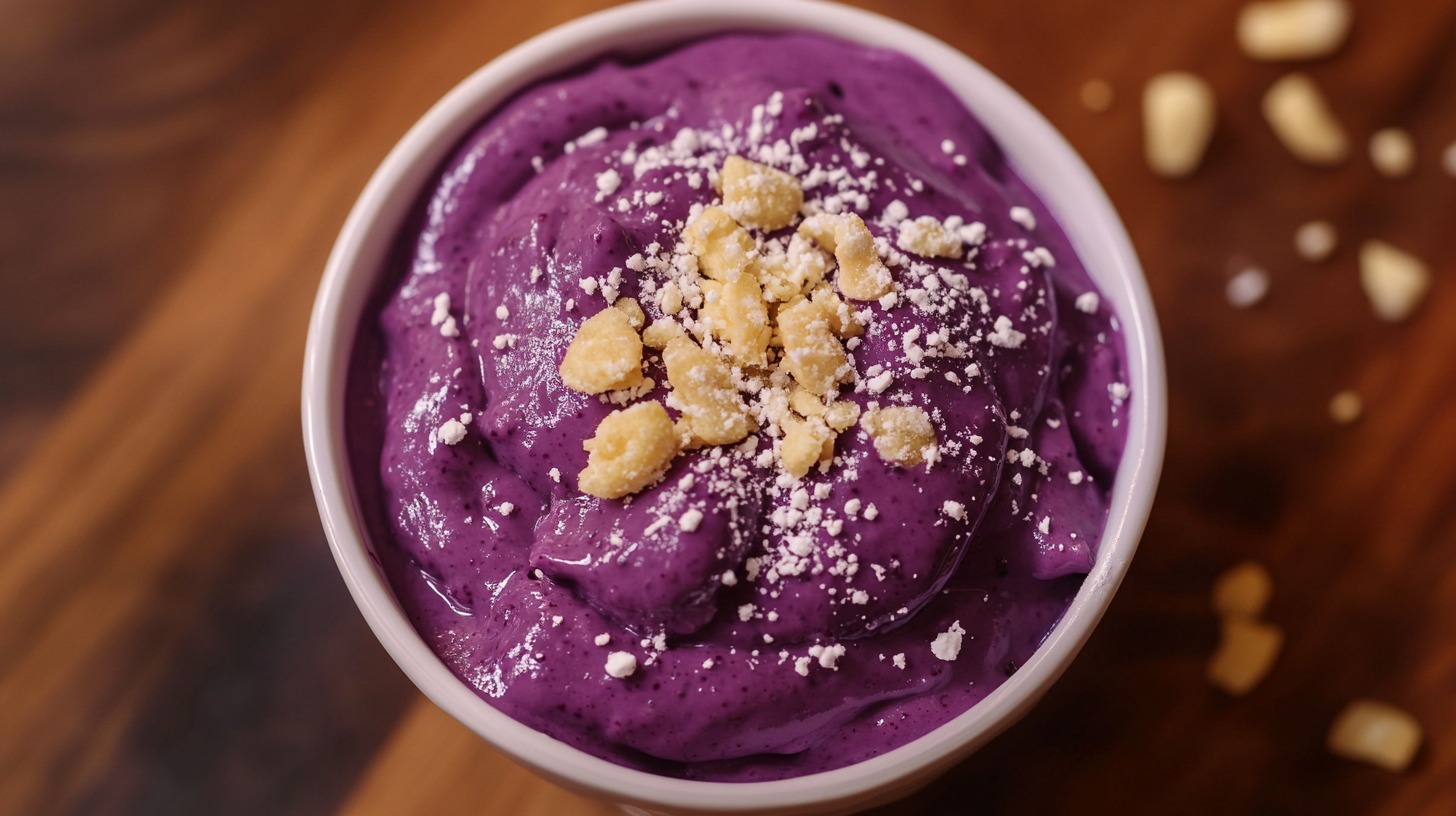
- Glutinous rice (1 cup)
- Ube halaya (1 cup, or more for stronger flavor)
- Coconut milk (2 cups, plus extra for drizzling)
- Sugar (4-5 tablespoons, adjust to taste)
Start by rinsing the glutinous rice under cold water until the water runs clear. This removes excess starch and ensures the rice doesn’t clump during cooking. In a medium-sized pot, combine the glutinous rice and coconut milk.
Bring the mixture to a gentle boil over medium heat, stirring occasionally to prevent sticking.
Once it begins to boil, reduce the heat to low and let the rice simmer, stirring frequently to ensure even cooking. The rice will absorb the coconut milk as it cooks, becoming soft and creamy. This process usually takes about 20-25 minutes.
If the mixture thickens too much before the rice is fully cooked, add small amounts of water or additional coconut milk to maintain a porridge-like consistency.
When the rice is tender, stir in the ube halaya. Mix well until the vibrant purple color is evenly distributed throughout the dish. Add sugar gradually, adjusting the sweetness to your preference. Allow the champorado to simmer for another 5 minutes, ensuring the flavors meld together beautifully.
If you’re interested in deserts from different cuisines, you can start with taco shells desert.
8. Strawberry Mochi
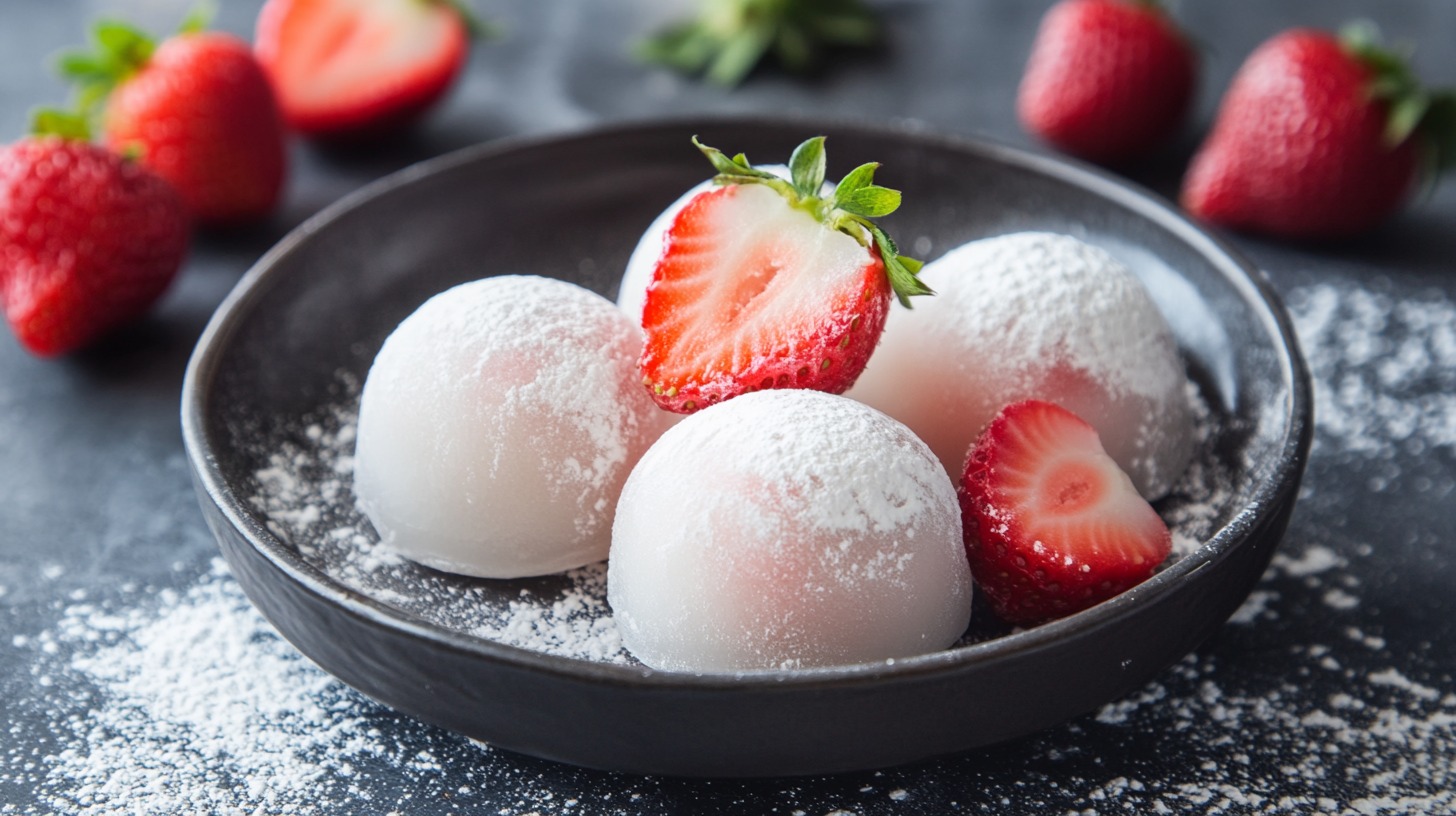
- Glutinous rice flour (1 cup)
- Sugar (2-3 tablespoons)
- Water (3/4 cup, adjusted as needed)
- Strawberries (8-10 medium-sized, washed and hulled)
- Sweet bean paste (about 1 cup, red or white, depending on preference)
Begin by preparing the strawberries. Wash them thoroughly, remove the stems, and pat them dry with a paper towel. Take a small portion of the sweet bean paste and flatten it in your hand. Wrap each strawberry in a thin layer of the paste, ensuring the fruit is completely covered. Set the wrapped strawberries aside.
Next, make the mochi dough. In a heatproof bowl, combine the glutinous rice flour and sugar. Gradually add water while stirring to form a smooth, lump-free batter. Cover the bowl with plastic wrap, leaving a small vent, and microwave on high for 2-3 minutes.
Stir the mixture halfway through cooking to ensure even consistency. The dough should be sticky, glossy, and fully cooked when done.
Dust your work surface and hands with cornstarch or potato starch to prevent sticking. Transfer the hot mochi dough onto the surface and let it cool slightly, but not completely, as it’s easier to handle when warm. Divide the dough into equal portions.
Flatten each portion of dough into a circular shape, ensuring the edges are slightly thinner than the center. Place a bean paste-wrapped strawberry in the middle of the dough. Gently pull the edges of the dough up and over the strawberry, pinching to seal at the top.
Smooth the seams by gently rolling the mochi in your hands.
9. Mango Pancakes
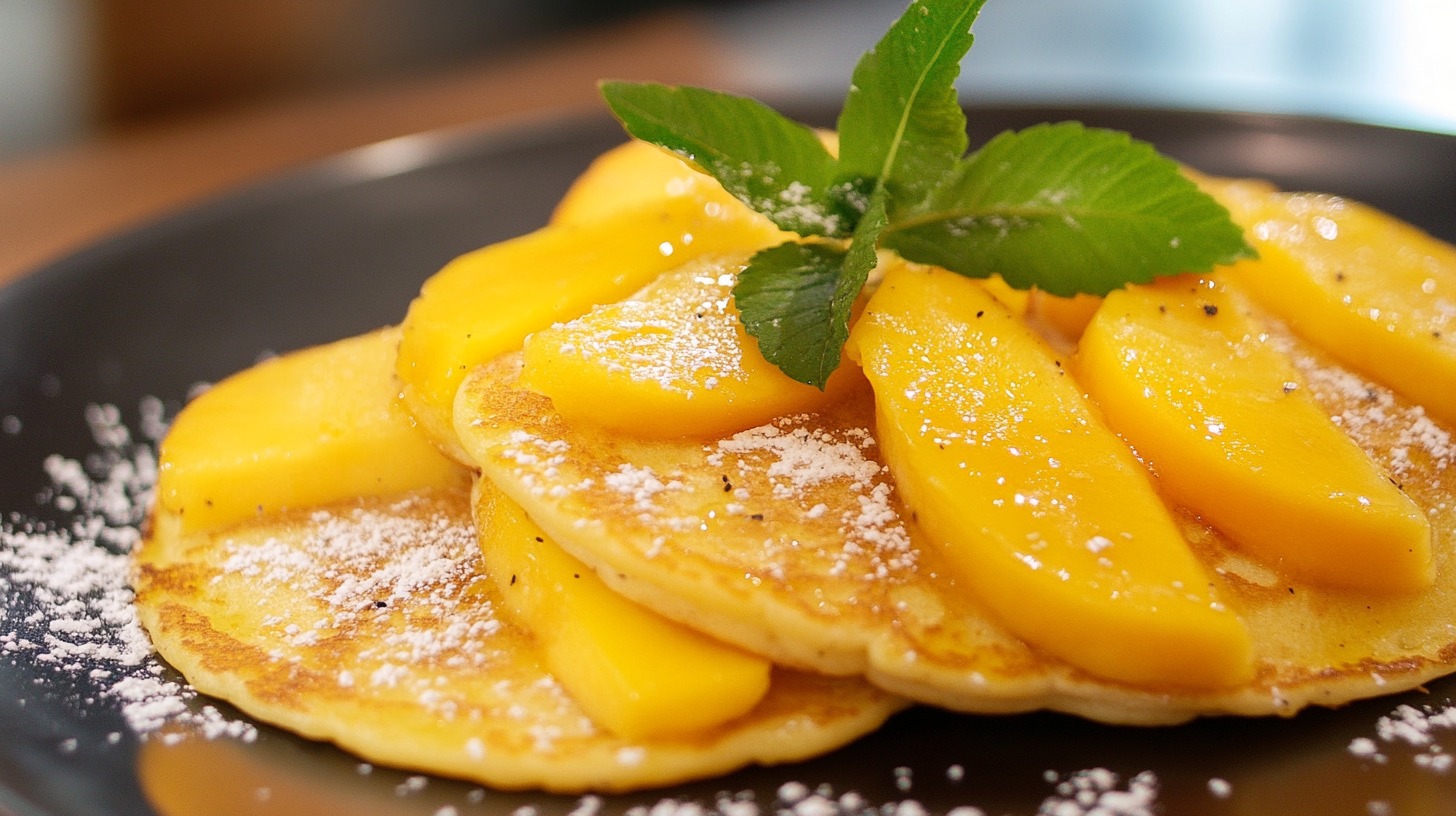
- Crepes (8–10 thin crepes, homemade or store-bought)
- Ripe mangoes (2–3 large, sliced thinly)
- Whipped cream (2 cups, freshly whipped or pre-made)
Start by preparing your crepes by making them from scratch. Whisk together flour, eggs, milk, a pinch of salt, and a bit of sugar until the batter is smooth and thin.
Heat a non-stick pan over medium heat, lightly grease it with butter, and pour a small amount of batter, swirling it to create an even layer. Cook for about 1-2 minutes per side, then set aside to cool.
If using store-bought crepes, ensure they are fresh and pliable. Peel the mangoes, remove the pit, and slice the flesh into thin strips or cubes for ease of layering. Fresh mangoes provide the best flavor, so choose ones that are juicy and sweet.
Lay one crepe flat on a clean surface or plate. Spoon a generous dollop of whipped cream into the center of the crepe. Arrange a few mango slices over the whipped cream, ensuring even distribution for a burst of mango flavor in every bite.
Fold the crepe neatly, first bringing two opposite sides together, then rolling or folding the remaining edges to create a secure parcel.
Repeat the process with the remaining crepes, whipped cream, and mango slices. For presentation, dust the folded crepes lightly with powdered sugar or drizzle them with honey.
10. Vietnamese Pandan Sticky Rice
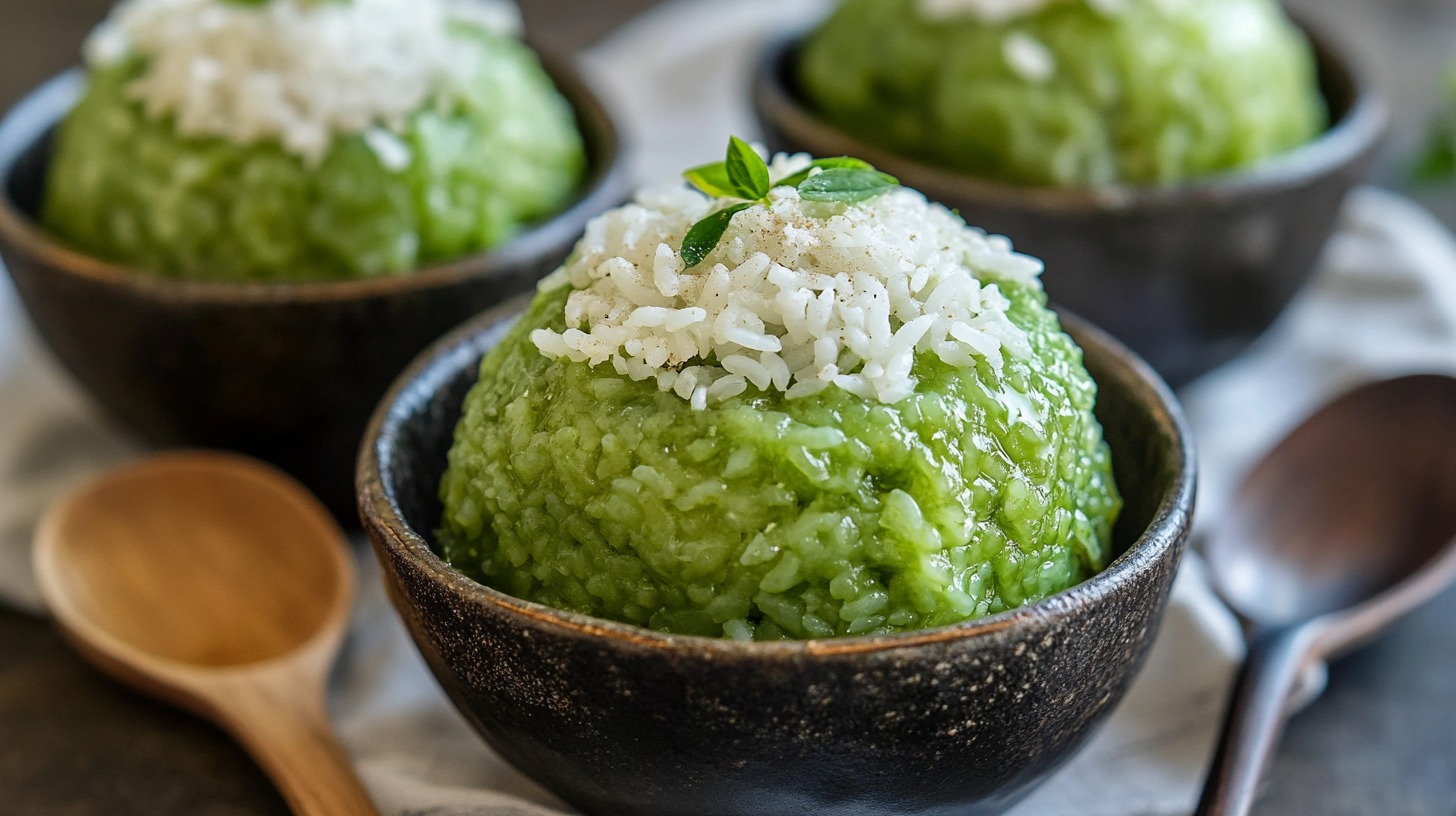
- Pandan leaves (10–15 fresh leaves or pandan extract for convenience)
- Sticky rice (1 cup)
- Coconut milk (1 can or about 400 ml)
- Sugar (4–5 tablespoons, adjust to taste)
Begin by rinsing the sticky rice thoroughly to remove excess starch. Soak the rice in water for 4–6 hours or overnight for the best texture. While the rice soaks, prepare the pandan juice by blending fresh pandan leaves with a small amount of water until smooth.
Strain the mixture through a fine sieve or cheesecloth to extract the vibrant green liquid. If you’re using pandan extract, skip this step and dilute the extract slightly.
Drain the soaked sticky rice and transfer it to a steamer. Before steaming, drizzle the pandan juice evenly over the rice, ensuring the grains are well-coated. Steam the rice over medium heat for about 20–25 minutes or until tender and fragrant. Stir occasionally during steaming to distribute the pandan flavor evenly.
While the rice steams, prepare the sweetened coconut milk. Heat coconut milk, sugar, and a pinch of salt in a saucepan over medium-low heat. Stir constantly until the sugar dissolves, taking care not to let the mixture boil. Reserve a portion of the coconut milk for garnishing.
Once the sticky rice is fully cooked, transfer it to a large bowl. Gradually mix in the warm sweetened coconut milk, stirring gently to ensure the rice absorbs the creamy sweetness. Cover and let it rest for 10–15 minutes to allow the flavors to meld beautifully.
11. Aiyu Jelly
- Aiyu seeds (50 grams)
- Water (1 liter, for jelly extraction)
- Lemon juice (2 tablespoons, freshly squeezed)
- Syrup (to taste, typically a mix of sugar and water or honey syrup)
Start by placing the aiyu seeds into a clean, fine-mesh cloth or a muslin bag. Secure the bag tightly, ensuring the seeds don’t spill out. Submerge the bag into a large bowl filled with cold water. Using clean hands, gently rub the bag in a circular motion for about 5-10 minutes.
After sufficient rubbing, you will notice the water thickening slightly. Remove the bag of seeds and let the liquid sit undisturbed at room temperature. Over the next 30-60 minutes, the jelly will set naturally. Avoid stirring or shaking during this period to achieve a smooth consistency.
Once the jelly has solidified, transfer it to the refrigerator to chill. For serving, scoop the jelly into bowls or glasses. Drizzle it generously with your prepared syrup, which can be as simple as sugar dissolved in water or honey thinned with a bit of water.
Add a splash of freshly squeezed lemon juice to enhance the flavor with a tangy brightness.
12. Japanese Strawberry Cake

- Sponge cake (1 medium-sized, pre-made or homemade)
- Fresh strawberries (2 cups, washed and hulled)
- Whipped cream (2 cups, freshly whipped or store-bought)
- Sugar (optional, for sweetening the whipped cream)
Begin by preparing the sponge cake if you are making it from scratch, ensuring it cools completely before assembling the layers. If using a pre-made cake, ensure it is light and airy for the best results. Gently wash and hull the strawberries, patting them dry to avoid excess moisture on the cake.
Slice the sponge cake horizontally into two or three even layers, depending on its height. If the whipped cream needs additional sweetness, fold in a small amount of sugar to taste before starting assembly. Spread a generous layer of whipped cream over the first sponge cake layer, smoothing it out evenly.
Slice some of the strawberries thinly and arrange them on top of the whipped cream layer for a fruity burst in every bite. Repeat this process with the remaining layers, ensuring even coverage of cream and strawberries.
For the final touch, cover the entire cake with a thin layer of whipped cream, smoothing it over the top and sides for a clean finish. Decorate the top with whole or halved strawberries arranged in a decorative pattern.
Chill the cake in the refrigerator for at least an hour to allow the flavors to meld and the whipped cream to set.
13. Ginataan Bilo Bilo
- Coconut milk (2 cans or about 800 ml)
- Taro (1 cup, peeled and diced)
- Sweet potatoes (1 cup, peeled and diced)
- Bananas (2-3 ripe saba or plantains, sliced)
- Tapioca balls (1/2 cup, soaked and drained)
- Mochi balls (1 cup, made from glutinous rice flour and water)
- Sugar (1/4 to 1/2 cup, adjust to taste)
- Water (2 cups)
Prepare the tapioca balls. Soak them in water for about 30 minutes, then rinse and drain. For the mochi balls, combine glutinous rice flour with water until it forms a soft, pliable dough. Roll the dough into small balls, roughly the size of marbles, and set them aside.
In a large pot, pour in the coconut milk and water, stirring to combine. Heat the mixture over medium heat until it comes to a gentle simmer. Add the diced taro and sweet potatoes, cooking them until they begin to soften, approximately 10-12 minutes.
Once the taro and sweet potatoes are tender, add the sliced bananas, tapioca balls, and mochi balls. Stir gently to prevent sticking. Allow the dessert to simmer for an additional 10-15 minutes, or until the tapioca balls turn translucent and the mochi balls are cooked through, developing a chewy texture.
Sweeten the ginataan by adding sugar, and adjusting to your preferred level of sweetness. Stir well to dissolve the sugar, ensuring the mixture is smooth and creamy.
14. Mango Sago
- Mangoes (2 ripe, peeled and cubed)
- Sago pearls (1/2 cup)
- Coconut milk (1 can or about 400 ml)
- Condensed milk (4-5 tablespoons, adjust to taste)
Start by preparing the sago pearls. Bring a pot of water to a boil and add the sago pearls, stirring occasionally to prevent sticking. Cook for 10-15 minutes until the pearls turn translucent with a slight white dot in the center.
Turn off the heat, cover the pot, and let the pearls sit for another 10 minutes until fully cooked. Drain and rinse the cooked pearls under cold water to remove excess starch, ensuring they remain chewy and not sticky.
While the sago is cooling, prepare the mango puree. Blend half of the cubed mangoes in a blender until smooth and set aside. Dice the remaining mango into small pieces for topping.
In a mixing bowl, combine the cooked sago pearls with coconut milk and condensed milk. Stir well to create a creamy base. Add the mango puree to the mixture and gently fold it in, allowing the flavors to blend. Adjust the sweetness with more condensed milk if needed.
Chill the dessert in the refrigerator for at least an hour to enhance its refreshing quality.
15. Chocolate Mochi Truffles
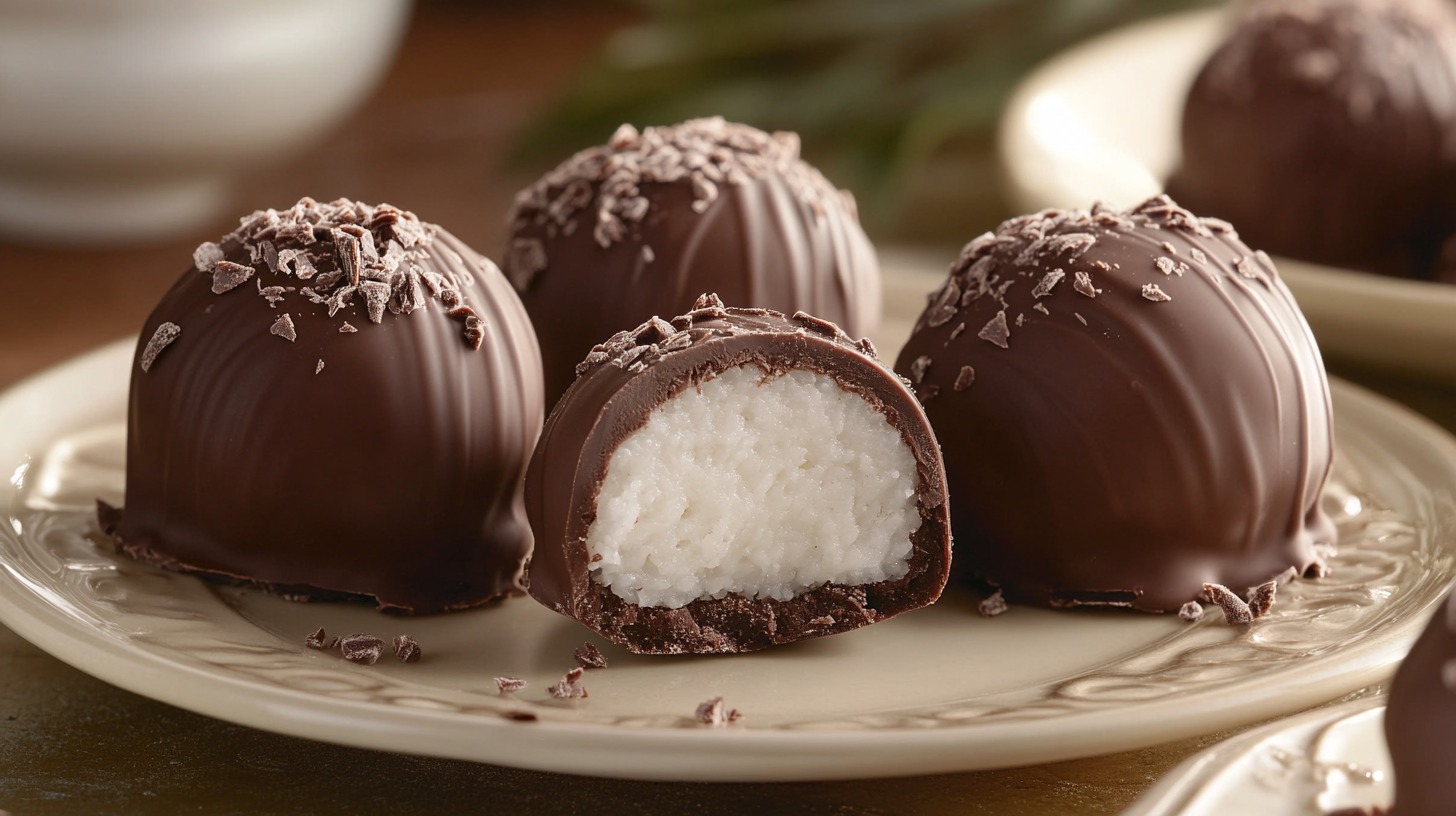
- Cocoa powder (for dusting)
- Glutinous rice flour (1 cup)
- Sugar (1/4 cup)
- Water (2/3 cup)
- Chocolate (your choice: dark, milk, or white, cut into small pieces or use chocolate chips)
Begin by preparing the mochi dough. In a microwave-safe bowl, combine the glutinous rice flour, sugar, and water, mixing until smooth and free of lumps. Cover the bowl with plastic wrap, leaving a small vent, and microwave the mixture on high for 1-2 minutes.
Stir the mixture, then microwave again in 30-second intervals until it forms a sticky, translucent dough.
Allow the dough to cool slightly, but not completely, as it needs to remain pliable for shaping. Dust your hands and a clean surface with cocoa powder to prevent sticking. Pinch off small portions of the mochi dough, about the size of a walnut, and flatten each piece into a thin circle.
Place a small piece of chocolate or a chocolate chip in the center of the flattened dough. Carefully wrap the dough around the chocolate, sealing the edges completely to form a smooth ball. Repeat the process until all the dough is used.
Roll each mochi ball in cocoa powder until fully coated, ensuring a rich and slightly bitter contrast to the chewy, sweet dough and creamy chocolate center. For added variety, you can experiment with fillings such as hazelnut spread, caramel, or even peanut butter.
16. Ube Cake
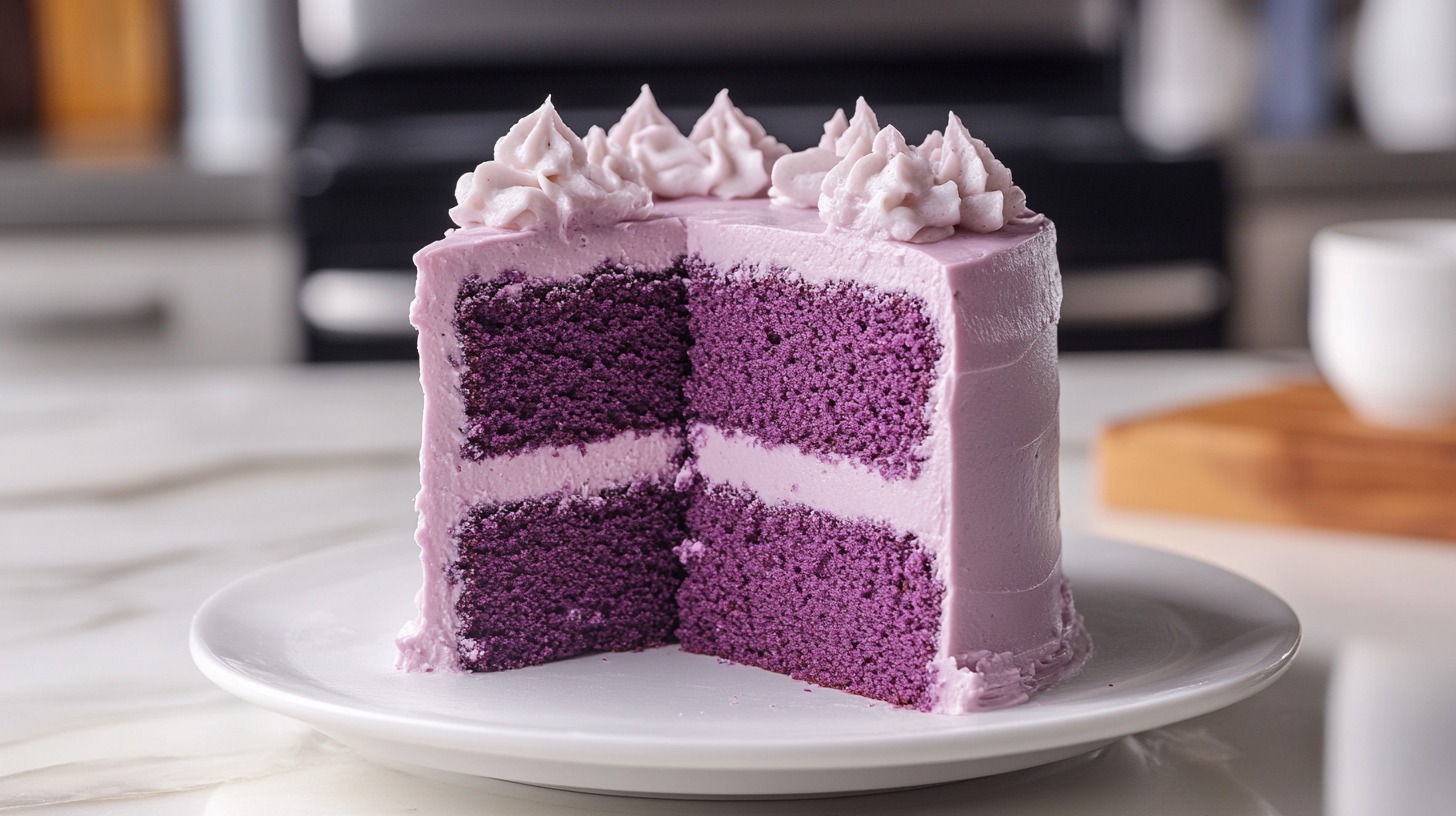
- Ube halaya (1 cup)
- Eggs (4 large)
- All-purpose flour (1 ¾ cups)
- Sugar (1 cup)
- Unsalted butter (½ cup, melted)
- Baking powder (2 teaspoons)
- Milk (½ cup)
- Ube extract (optional, 1 teaspoon for enhanced color and flavor)
Start by preheating your oven to 350°F (175°C) and preparing your cake pan by greasing it and lining it with parchment paper. In a large mixing bowl, sift together the flour and baking powder to ensure the cake has a light texture.
In another bowl, whisk the eggs and sugar together until the mixture is pale and fluffy. Slowly add the melted butter and milk, mixing until well combined. Stir in the ube halaya, ensuring it is evenly incorporated. If you desire a more vibrant purple color or a stronger ube flavor, add a teaspoon of ube extract.
Gradually fold the dry ingredients into the wet mixture, using a spatula to avoid overmixing. The batter should be smooth and slightly thick. Pour the batter into the prepared cake pan and smooth out the top.
Bake the cake in the preheated oven for 30-40 minutes, or until a toothpick inserted in the center comes out clean. Allow the cake to cool in the pan for 10 minutes before transferring it to a wire rack to cool completely.
17. Vietnamese Chè Ba Màu (Tri-Color Dessert)
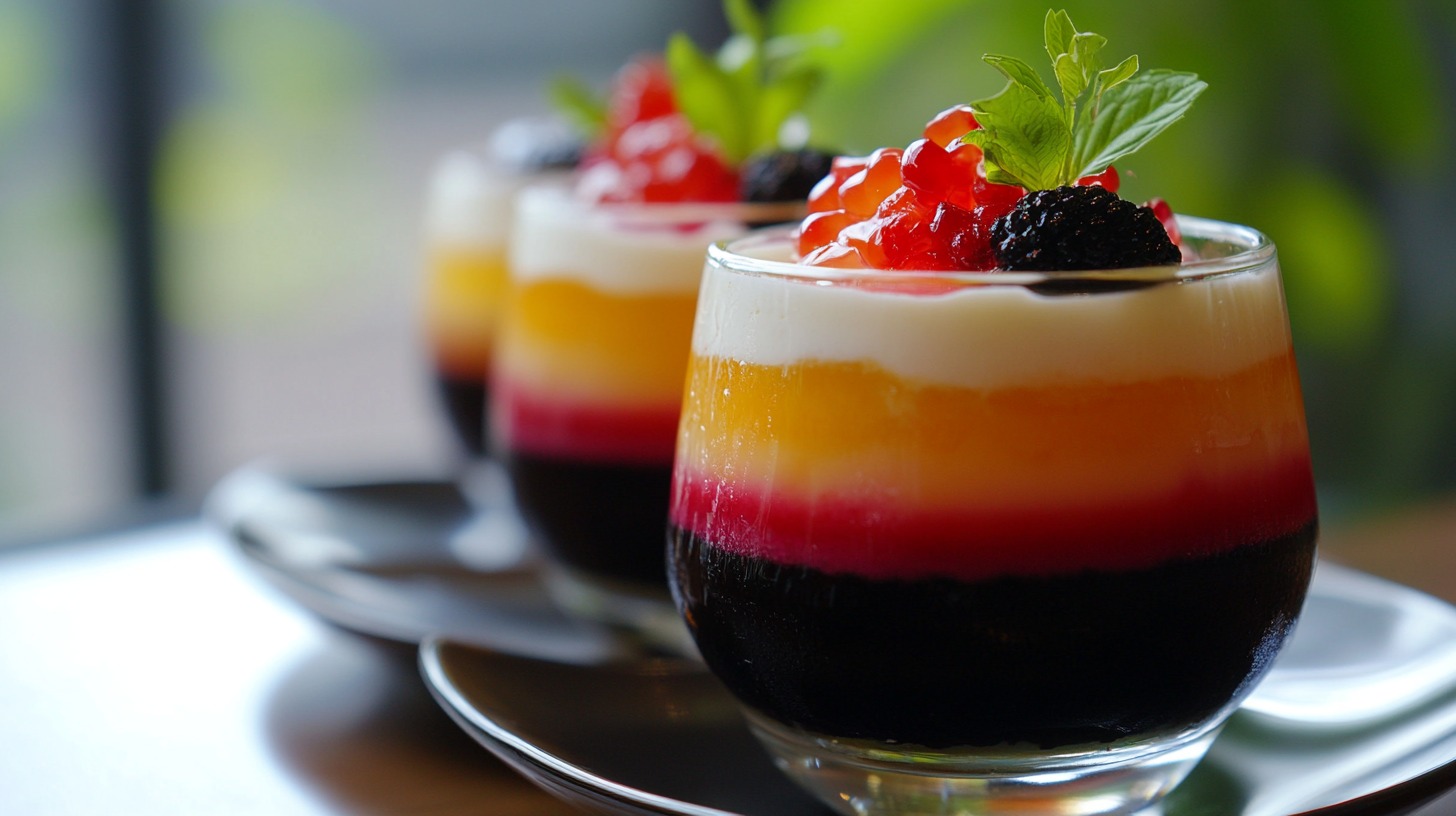
- Mung beans (1/2 cup)
- Pandan jelly (1 cup, diced)
- Red beans (1/2 cup, sweetened or cooked with sugar)
- Coconut milk (1 can or about 400 ml)
- Sugar (4 tablespoons, adjust to taste)
- Water (for boiling and making syrup)
Begin by preparing the mung beans. Rinse them thoroughly and soak them in water for at least 2 hours. After soaking, boil the mung beans until tender, then drain and mash lightly. Sweeten the mung beans by mixing in a small amount of sugar while they’re still warm. Set aside to cool.
For the pandan jelly, prepare a jelly base using pandan extract or juice combined with agar-agar or gelatin. Follow the instructions on the jelly packet, allowing it to set completely before cutting it into small cubes.
Next, prepare the red beans. If using canned sweetened red beans, drain them lightly. If starting with raw red beans, soak them overnight, boil until soft, and sweeten with sugar to taste.
In a separate saucepan, heat the coconut milk with sugar until the sugar dissolves. Avoid boiling to maintain a creamy consistency. Let this coconut syrup cool completely.
To assemble, take a tall, clear glass and start layering. Begin with a spoonful of the sweetened mung beans at the bottom, followed by a layer of pandan jelly, and then the red beans. Repeat the layers if desired to create a visually striking presentation.
Pour the cooled coconut milk syrup over the layers until the glass is filled.
18. Black Sesame Ice Cream
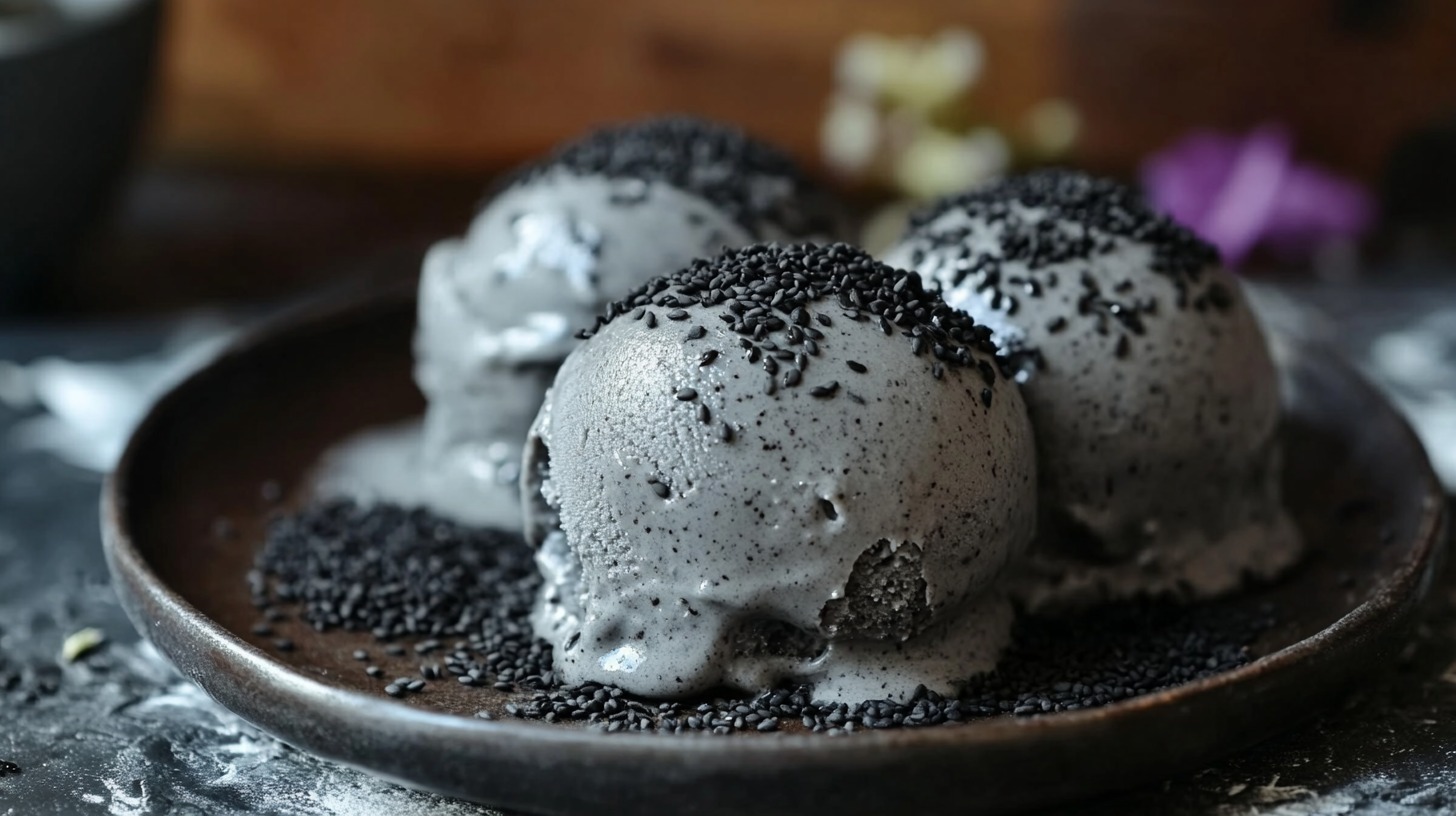
- Black sesame seeds (1/4 cup)
- Heavy cream (2 cups)
- Whole milk (1 cup)
- Sugar (1/2 cup, adjust to taste)
Begin by toasting the black sesame seeds to release their nutty aroma and rich flavor. Heat a dry skillet over medium heat and add the sesame seeds, stirring constantly for 3-5 minutes until they are fragrant and slightly darkened. Be careful not to burn them, as this can result in a bitter taste. Once toasted, let the seeds cool slightly.
Transfer the cooled sesame seeds to a food processor or high-powered blender. Blend the seeds until they form a fine powder, then gradually add the milk while blending to create a smooth, thick sesame paste. For an even smoother texture, you can strain the paste through a fine sieve to remove any larger particles.
In a medium saucepan, combine the sesame paste, cream, milk, and sugar. Heat the mixture over low to medium heat, stirring constantly, until the sugar dissolves completely and the mixture is well combined. Do not let it boil, as this can affect the creamy consistency of the ice cream. Once combined, remove the saucepan from the heat and let the mixture cool to room temperature.
19. Bánh Cam (Vietnamese Sesame Balls)
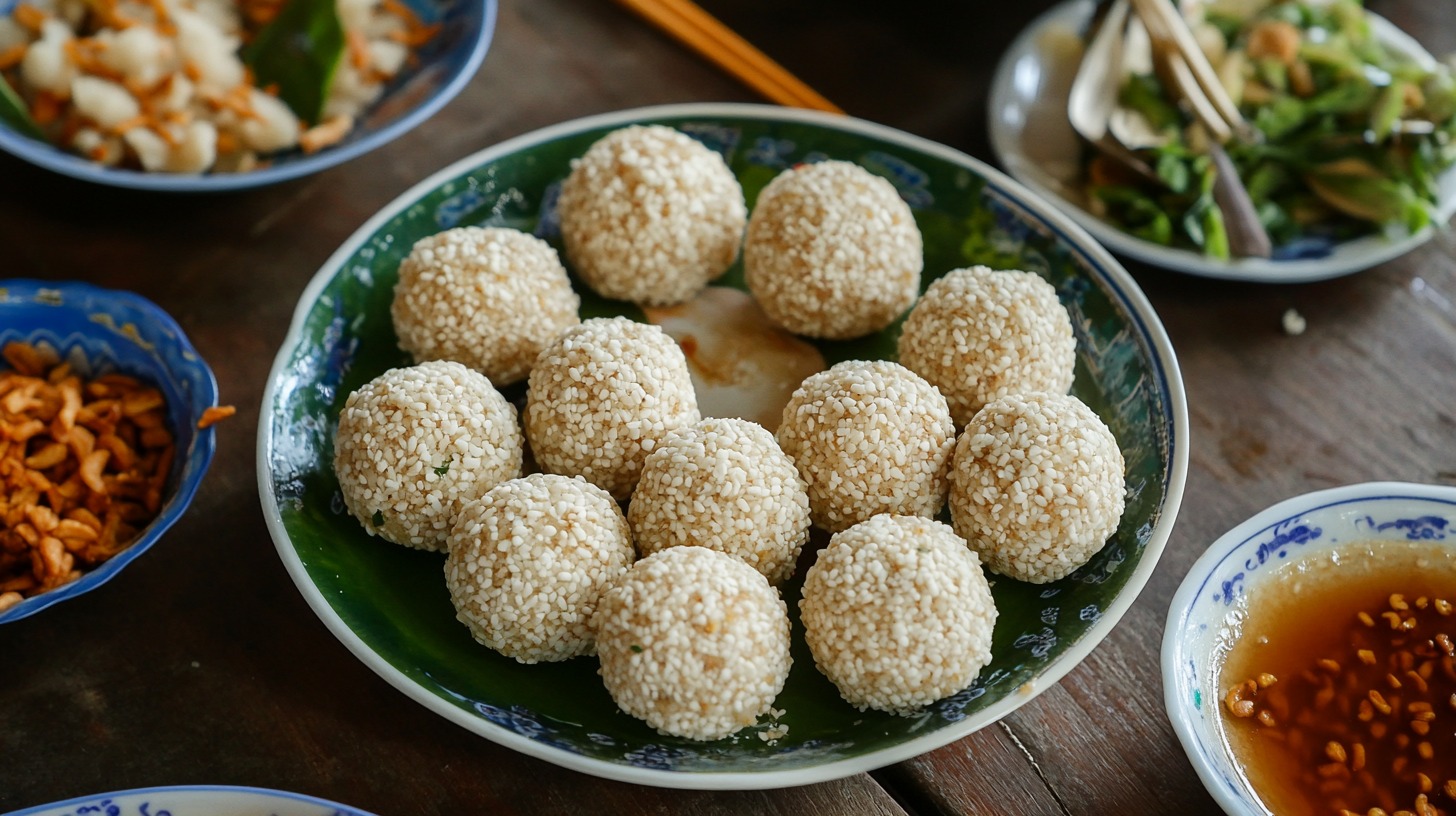
- Mung bean filling (1 cup cooked and sweetened mung beans, mashed into a paste)
- Glutinous rice flour (2 cups)
- Sugar (1/4 cup)
- Warm water (about 3/4 cup, adjust as needed)
- Sesame seeds (1/2 cup)
- Vegetable oil (for frying)
If starting with dried mung beans, soak them in water for at least 4 hours, then steam or boil until tender. Mash the cooked beans with sugar to create a smooth paste, and let it cool. Divide the paste into small portions and roll them into balls, about the size of a marble. Set aside.
To make the dough, combine glutinous rice flour and sugar in a mixing bowl. Gradually add warm water while kneading the mixture until it forms a soft, pliable dough that doesn’t stick to your hands. Cover the dough with a damp cloth and let it rest for 15-20 minutes.
Divide the dough into small portions, slightly larger than the mung bean balls. Flatten each piece of dough and place a mung bean ball in the center. Carefully wrap the dough around the filling, rolling it between your palms to form a smooth ball. Ensure the filling is completely enclosed.
Next, roll each ball in sesame seeds, pressing gently to ensure an even coating. Heat vegetable oil in a deep pan or wok over medium heat. Once the oil is hot, gently lower the sesame balls into the oil, frying in small batches to avoid overcrowding.
Fry the balls while turning them occasionally to ensure even cooking. When they become golden brown and crispy, remove them from the oil and drain them on a paper towel.
20. Korean Mochi Bread (Chapssal Doughnuts)
- Glutinous rice flour (2 cups)
- Sugar (1/4 cup, adjust to taste)
- Milk (1/2 cup)
- Baking powder (1 teaspoon)
- Optional: Cinnamon or powdered sugar for dusting
Start by combining the glutinous rice flour, sugar, and baking powder in a mixing bowl. Gradually add milk while stirring to form a soft and smooth dough. The texture should be pliable but not sticky; add a little more flour or milk if needed to adjust consistency.
Once the dough is ready, divide it into small portions and roll each into a ball about the size of a walnut. Ensure the balls are evenly sized for consistent frying. If you prefer, you can flatten the dough balls slightly to create a disc shape for a different texture.
Heat oil in a deep frying pan or pot to about 350°F (175°C). Carefully drop the dough balls into the hot oil, frying in small batches to avoid overcrowding. Cook the doughnuts for 3-5 minutes, turning occasionally, until they are golden brown and puffed up.
The outside should be crisp, while the inside remains chewy and soft.
The Bottom Line
Asian desserts celebrate flavor, creativity, and culinary heritage.
Every recipe presents an enjoyable combination of textures and tastes that make them stand out.
These iconic dishes are perfect for gatherings, special occasions, or simply treating yourself to something sweet and satisfying.

